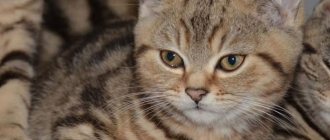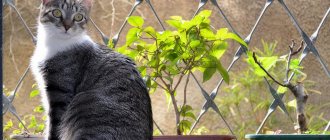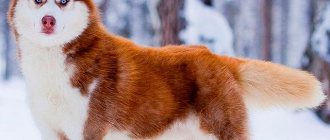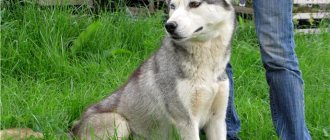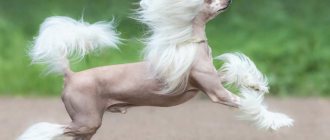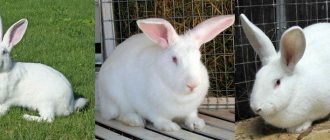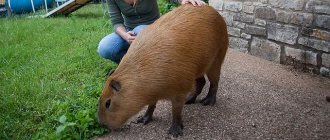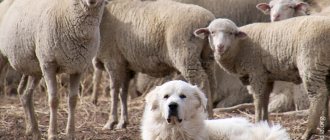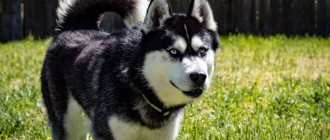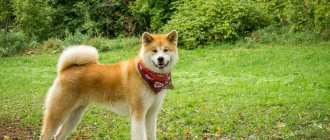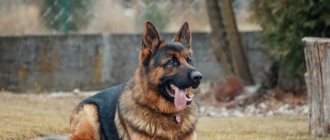The variety of colors of mustachioed pets is striking in its diversity. Animals differ from each other not only in the predominant color, but also in the degree of coloring of the hairs, as well as the presence or absence of a pattern on the coat.
All these features depend entirely on genetics, so to preserve them it is very important to follow a number of certain rules when mating. Below you can get acquainted with all the existing colors of cats and cats using photos and find out the names of the breeds to which they are assigned.
Genetics is the basis of everything
The ancestors of modern “mustachios” inhabited the hot savannas of Africa and the forests of Europe. At that time, cats used color solely for the purpose of survival and hunting. Inconspicuousness on the sand, among bushes and tree branches was achieved thanks to gray and brown tones, as well as numerous stripes and spots scattered over the entire surface of the fur coat. As a result of domestication and subsequent selection, cat colors have become more diverse and unusual.
The color of the hairs is determined by a special pigment - melanin, which is divided into 2 types:
- pheomelanin, which gives pigmentation in the red-yellow-orange spectrum by reflecting the rays of the sun;
- eumelanin, which gives black pigmentation by absorbing the rays of the sun.
Experienced cat owners will confirm that the coat of male cats has a less rich color palette. This is also explained by genetics.
Pheomelanin and eumelanin activate 2 genes: O and o, respectively. They are present only on X chromosomes, that is, the coat color is firmly linked to the sex. In the genetic code of females there are as many as 2 X chromosomes, so they have 3 basic colors available to them:
- red, or red (OO);
- black(oo);
- tortoiseshell (Oo).
Males have only one X chromosome. The latter option is not typical for them, but still sometimes occurs and is accompanied by infertility.
The genes listed are only part of a huge system. In addition to them, there are also those that are responsible for the saturation, brightness and contrast of the final color. Based on these characteristics, all existing cat colors are divided into the following types:
- solid, or solid;
- colors with white, including piebald;
- tabby, or tabby;
- tipping, or typed;
- color point, or acromelanism.
The coloring of the kittens' coat depends on the correct crossing of their parents. For this reason, breeders of purebred animals strictly monitor the pedigree and be sure to check the documents of partners for the upcoming mating.
Rare and expensive
List of the most expensive (cost in dollars):
- Laperm - three hundred to two thousand;
- Serengeti - six hundred to two thousand;
- Elf - six hundred to two thousand;
- Kao-Mani - seven to ten thousand;
- Savannah - from twenty-two to one hundred thousand.
Also read the article about the most expensive cat breeds.
The cost of a rare pet depends on its class, gender, and nursery. A PET-class kitten (without documents) will cost several times less than an individual from titled parents. The cost of females is usually higher than that of males. In foreign nurseries, animals are more expensive.
Read the article about the most beautiful cat breeds.
Solid colors of cats
The solid color of cats, or solid, is monochromatic. It does not contain extraneous drawings, which is completely inconsistent with the natural design. For this reason, most of the representatives from this group are the result of the hard work of breeders.
Are there completely white and black animals?
In nature, completely white and black colors do not exist. The only exceptions are unfiltered sunlight and the depths of a black hole. In the coloration of cats, such colors are achieved by multiple accumulations of spots.
The appearance of a large number of white hairs on the body is associated with the complete absence of coloring pigment in albinism or its partial suppression. In the second case, the animal becomes uniformly white due to many white spots that visually merge, or piebald.
Dominant white, a lack of color not associated with albinism, is also possible. These cats have a soft coral hue to their nose, ears, paw pads and eyelids.
The piebald color group involves the presence of colored spots on a white background and includes the following subspecies:
- Wang
. Maximum amount of white, diluted with small colored spots on the tail, head or back of the paws.
- Harlequin
. The predominance is still on the side of white, but there are more colored spots. In addition to the head, they cover the sides and back, and the entire tail is colored.
- Bicolor
. Most of the body is covered with colored spots, and the residual white creates a fancy pattern in the form of “gloves”, “medallion”, “tuxedo”, “cap”, “buttons”, “saddle” and “socks”.
- Calico, or tricolor
. The predominance of white in combination with tortoiseshell.
A completely black coat is more common than a snow-white one. It is formed by a combination of the dominant o gene and the recessive non-agouti gene, which masks the wild pattern. The features of non-agouti and body patterns will be discussed in more detail in the “tabby or tabby” section.
Rare and common colors
Common cat colors include those approved by international felinological organizations. These include:
- black;
- red;
- tortoiseshell;
- blue;
- chocolate;
- cream;
- blue-cream tortoiseshell.
If the color appeared quite recently and representatives with such a coat are difficult to breed due to their rarity, then it is not recognized. The most unusual of them include cinnamon (cinnamon), fawn (deer), apricot, and lilac.
“
INTERESTING!
Under the red and cream color, the pattern often breaks through, which makes it very difficult to achieve their uniformity.
Examples of breeds
The most notable black cat is the Bombay. A snow-white coat is typical for the Kao Mani and Turkish Angora, a chocolate coat for the Havana Brown, and a blue coat for the Chartreuse and Russian Blue.
Bobtails
Also a short-tailed group of cats. As a rule, bobtails are distinguished by their large size and dense, wet-resistant coat.
Tails can be of the following forms:
- Stump. From 2 to 5 cm. There are breaks at an obtuse angle.
- Spiral. The apparent length is 5–10 cm. There are numerous fractures, often at sharp angles.
- Retracted bobtail. Near the base the tail is normal, after 5–7 vertebrae kinks begin.
- Panicle. Length from 5 to 15 cm, breaks at right angles.
Bobtail breeds
There are several breeds of bobtails.
American
The head is wedge-shaped. The body is moderately long, the back is straight. Weight 3–8 kg. The coat can be short or semi-long.
Yankeebobs with semi-long hair should have a collar
Japanese
The head is triangular. Individuals with eyes of different colors are often found. The body is oblong, muscular, but not massive. Weight 3.5–5 kg. The coat is short.
In Japan, this cat symbolizes friendship, in Korea and China - well-being.
Kuril
The head is in the shape of an equilateral triangle. The body is strong and muscular. Weight 3–7 kg. The coat is semi-long and thick. There may be tufts on the ears, making the animal look very much like a lynx.
Thick, warm fur helped Kurilian Bobtails survive in the wild
Mekong
The head is rounded. The body is rectangular in shape, but quite slender. The only colors allowed are Siamese. Weight 2.5–5 kg.
According to legend, these animals accompanied the princesses, and while they were bathing, they strung jewelry onto the cats' broken tails.
Karelian
The head is triangular, the muzzle is narrow. The body is strong, the hind legs are noticeably longer. The coat can be short or semi-long.
Karelian Bobtail is the rarest variety
Character
Bobtails are conspicuous companions. They love to spend time in human society and are painfully sensitive to loneliness.
The most independent bobtails are the Mekong.
Most of these animals are very active and love outdoor games. They are smart and often have developed logical thinking. Most often they respond well to training. Usually travel easily.
As a rule, they get along peacefully with cats and dogs. Most of all, the “Japanese” love the company of other animals, and they prefer to be friends with representatives of their own breed.
The hunting instinct is pronounced. Many bobtails are excellent rat catchers, and some - for example, Kuril and Japanese - can fish.
Most are quite sociable, often making rich intonation sounds similar to chirping or abrupt yelps, but not to a regular meow.
The quietest and calmest of bobtails are Karelian. If such a cat needs something from its owner, he would rather touch it with his paw than meow.
Moti's character is simply unique. It’s not for nothing that kurbob is called cotops. He chose me as his owner, and it's obvious. He only sits in my arms and follows me around the house. My husband says that he even feels when I should come - he runs to the door. And when I’m not home for a couple of days, the cat... howls. Drawingly, long, like a dog. Despite the fact that both his husband and mother feed him, he keeps them at a distance. Bored, my red “Hachiko” curls up on some of my clothes. I even specially leave him some old things if I’m away for a long time, as an “anti-stress.”
Martovskaya
https://irecommend.ru/content/ne-pakhnet-i-ne-metit-ili-antikvar-v-koshachei-shkure-zabavnye-foto
Care
Short-haired bobtails are usually brushed once a week, while semi-long-haired ones are brushed once every 2-3 days. During the molting period, this is done daily. If necessary, you can bathe the animal approximately once every 2 months.
Video: Kurilian Bobtail - all the details about the breed
Tabby, or tabby
Tabby is the most ancient coloring, inherited by domestic cats and cats from their wild ancestors. It is distinguished from solids by the presence of a pattern that facilitates mimicry - camouflage to the environment.
Varieties
Tabbies are characterized by zonal hair coloration, which is a uniform alternation of dark and light areas, like on a police baton. Depending on the order of arrangement and appearance of the lines inside the color, 4 subspecies are distinguished:
- Spotted
. The body of the animal is covered with round spots of different sizes. On the tail and in the lower part of the limbs the shape changes to oval and can merge into stripes.
- Marble
, or
classic
. It is a combination of wide spiral stripes diverging on the sides and reminiscent of marble stains. In addition to this feature, the fur coat has spots in the belly area, rings along the tail and paws, as well as 3 stripes in the area of the shoulder blades, similar to the open wings of a butterfly. - brindle
, or
mackerel
. Characterized by thin vertical stripes scattered throughout the body. The rings are found strictly on the tail and limbs, and a continuous dark stripe runs along the spinal column. - Ticked
. This color is found in Abyssinian cats, so it is sometimes carried separately. Its detailed description will be given below.
Another gene is responsible for the appearance of the pattern on the coat - agouti, as well as its possible form, or allele - non-agouti. The first makes the tabby distinguishable, while the second suppresses and disguises it. Thus, in the presence of non-agouti, the tabby turns into a solid.
“ INTERESTING!
Protection from the effects of non-agouti is only provided by the O gene, which is responsible for the red and cream tint. For this reason, all fluffy saffron milk caps have an open pattern, which can only be removed through painstaking breeding work.
Residual tabby in kittens confirms that all whiskered pets are tabbies, but not all are agoutis. Because of this, with solid colors, the pattern disappears immediately after the juvenile molt.
Examples of breeds
The most famous “mustache” with a marbled coat is the short-haired British kitten from the Whiskas advertisement. The presence of spots is typical for savannahs, Ocicats and Bengals. Stripes are the least common. They can be found in the Toyger, a close relative of the Bengal.
Famous, popular plush breeds of cats and cats: photos, character description
Some cats have short but very thick fur that gives them the appearance of a plush toy. This fur is extremely pleasant to the touch. The most famous and popular are these “buns”.
British Shorthairs are bright representatives of the “plush” breed. Strong, serious animals, with a round head and serious eyes. These cats have remarkable properties:
- calm
- clean
- endowed with high intelligence
- affectionate
- loyal to their masters
- rarely bite or scratch
- They easily tolerate loneliness. Ideal for people who are not often at home
- don't like to be squeezed
- gets along easily with other pets
- unpretentious in food
British Shorthair
The British chinchilla is a calm and inactive cat, bred as a result of crossing the British and Persian breeds.
Characteristics:
- very lazy, prefer to lie down all day
- affectionate and gentle
- they need constant attention from their owners
- easy to adapt and learn
- patient
- need their own corner and do not like it when people encroach on their territory
- not aggressive, but quite stubborn
British Chinchilla
Exotic Shorthair is a pussycat that captivates people's hearts with its naive face and plush fur. The breed was created by accident, but quickly gained popularity. These cats are similar to Persian cats, only with short hair.
Exotics have an almost ideal character:
- good-natured and affectionate
- curious
- lazy couch potatoes
- do not make noise, preferring quiet games with toys
- devoid of aggression, in case of an incorrect attitude they simply leave offended
- indifferent to strangers
Exotic Shorthair
Scottish Straight (Scottish Straight) is a fluffy, strong representative of the Scottish breed, endowed with a wonderful character:
- friendly, non-aggressive
- quickly becomes attached to all family members
- calm and sedate
- afraid of heights
- cannot tolerate coercion or being held in arms by force
Scottish straight
Ticked cat colors
The main feature of ticked color in cats is the vagueness of the pattern. It's like he's covered with a light veil. Residual stripes are observed only on the muzzle. Its relationship with other varieties of tabby can be determined by the mesmerizing shimmer of the coat, achieved through zonal hair coloring.
Initially, ticking was found only in “Abyssinians,” but over time, breeders achieved its manifestation in other breeds: Ragamuffin, Chausie, “British,” LaPerma, Cornish Rex, “Oriental,” Manx and others.
The requirements for these animals are much lower than for Abyssinian cats. Their standard allows for open “necklaces” on the neck, the letter “M” on the forehead (scarab sign) and stripes around the paws and tail.
Black breeds of cats and male cats: photos, description of character
Black cats are quite common. Almost all breeds can have this color: both short-haired and long-haired. It is believed that black cats have special telepathic abilities and sense their owners well. There are few breeds that are exclusively black in color.
The Bombay cat is a breed that has been created by breeders for more than 20 years. The animal has smooth short hair and is very similar in appearance to a panther. Throughout life, a cat's eye color changes: at birth it is blue, then becomes gray, and then acquires an amber tint.
Features of this breed:
- have a bright temperament
- have a very individual character
- have high intelligence
- they meow a lot, but their voice is quiet, so they are perceived without tension
- don't like loneliness
- happy to sit in your arms
- balanced
- they try to take a leading position among other pets
Mandalay
Bombay cat is a new rare breed that is not fully recognized. These are descendants of Burmese with a specific thick, uniform dark chocolate or black color. The wool literally shimmers and feels silky and pleasant to the touch.
Main features:
- calm and friendly
- love all family members without singling out anyone
- patient
- love affection and attention
Mandalay
Tipping
On average, when ticking, the hair is divided into 3 alternating zones. Tipping is a fairly close concept, but has two differences:
- Number of zones. Usually there are only two of them: light at the bottom and dark at the top.
- Mechanism of coloring. The lower part of the hair is lightened to white by complete or partial loss of pigment due to the dominant silver gene. In the first case, it becomes white, and in the second, yellow or apricot.
Depending on the degree of black coloration, several varieties are distinguished in this group. As with tabbies, the final color of a cat when tipped is determined by the presence of the agouti gene.
Haze and shaded
Haze and shaded colors are similar, but still separate varieties. In both places there is a dominant silver gene, but its manifestation depends on the agouti gene:
- Smoky
. Owners of this color carry the non-agouti allele in their chromosomes, which excludes the pattern. Because of this, the smoky coat of cats is often confused with a plain coat. The silveriness appears strictly when moving, when the hairs move apart and expose almost 50% of the white base.
- Shaded
. With this variety, only ⅓ of the hair is dyed. Due to the presence of the agouti gene, a pattern is formed on the fur coat, creating the effect of a translucent veil.
Depending on the color of the tips of the hairs, the haze can be blue, purple, black, chocolate and red. The presence of residual stripes in smoky colors is not allowed.
“ REFERENCE!
In addition to the standard haze, there is also a reverse haze, when it is not the base of the hairs that is painted white, but their ends.
Silver and gold
In this section, it is important to clarify that, unlike solids and tabbies, tipping is only a method of coloring. It is not a separate group of colors in cats. The color variations created by tipping are called silver. In addition to haze and shaded, 2 more colors are classified as silver:
- Silver tabby
. A unique option for zonal coloring with lightening of light areas to whiteness. The dark shade in this case retains its original color. Thanks to this, a pattern characteristic of a tabby appears on the body.
- Veiled, or chinchilla
. It is characterized by coloring only ⅛ of the hair. As with the ticked paint, the chinchilla will be disassembled separately just below.
Both varieties, like the shaded one, appear under the condition of the simultaneous presence of the silver and agouti genes. The first suppresses the production of both types of melanin, but has a greater effect on pheomelanin.
If there is an excess amount of red pigment (red and cream coat), its blocking fails. It gives a unique cameo color, when instead of dark tips, light ones are formed. As in the case of a chinchilla, the dyed part accounts for ⅛ of the total length of the hair.
“ NOTE!
The blue coat is often confused with the silver coat, but it still belongs to the solids. This confirms the absence of a white base in the hairs.
Unlike silver, gold consists strictly of red-yellow-orange colors. With this coloring, the color is preserved in both zones, but the upper one is painted more brightly and intensely. If the top layer accounts for ⅓ of the hair, then the color is called shaded gold, and if only ⅛, then veiled. In both cases, the golden cat is always green-eyed.
The golden color of the fur coat is the most expensive and rare. It is difficult to breed as the exact reason for its inheritance has not yet been identified. Mating of two golden individuals does not always give the desired result, since any inconsistency of genes leads to the suppression of pheomelanin.
Examples of breeds
The smoky color, like many others, is allowed by the American Curl standard. A brighter owner of the haze is the Australian mist, or Australian smoky. A silver coat is the calling card of the oriental beauty of Singapore, and bright gold is the most expensive color option for the chubby-cheeked “British”.
Chinchilla
With this color in cats, only the very tip of the hair is colored, and most of it remains white. The name “chinchilla” was given for a reason. The coat of animals with this color really resembles the fur of rodents or an arctic fox fur coat. An additional bonus is the extraordinary softness and fluffiness.
In addition to silver chinchillas, golden ones are also found. They are distinguished by a soft apricot undercoat. Regardless of the final color, all chinchillas have black eye and nose rims, black paw pads and bright green eyes.
Raas
- Height: 29-36 cm
- Body weight: up to 6.8 kg
- Lifespan: 12-15 years
- Temperament: Playful, stubborn, energetic and independent
Raas is a breed of domestic cat that originated on the Indonesian island of Raas. Their physical characteristics are very similar to a wild jungle cat or leopard. These cats are larger than most other breeds. The raas has a square-shaped muzzle, a slightly pointed chin, erect ears, and dark green eyes.
There are many myths about them. One states that these felines have a sixth sense , and can only be kept by a certain group of people, such as clergy and community leaders. Another myth says that if a person decides to take a raas off the island, his luck will turn away.
Raas are energetic and playful, but seem to be afraid of humans and sometimes have difficulty adapting. However, it is quite possible to tame them, but you will have to be patient, since from time to time the Raas can be stubborn and grumpy.
Color point or acromelanism
The English phrase color point is translated as “color spot”. With this color, kittens are born blue-eyed and almost snow-white. With age, most of their body remains either white or changes to cream, and its extremities (muzzle, tail, ears, paws) darken and acquire more saturated colors:
- tortoiseshells;
- solids;
- tabby
Color point is a form of albinism. It is part of the group of acromelanistic colors that depend on body temperature. So-called points, or dark spots, appear where it is colder. The snow-white appearance of kittens is the result of their high temperature, which is 38.5-39.5°C. In adults, this figure is much lower – 37.5-38.9°C.
Varieties by shade
Depending on the main color of the cat and its point, several subspecies are distinguished in this group. These include:
- blue point - blue;
- chocolate point – brown;
- tortoiseshell (tri-color);
- lilac point – gray-pink;
- seal point – dark brown-gray, close to black;
- red point – red (red);
- cream point – cream (beige);
- tabby point - spotted or striped.
The acromelanism gene can also produce full albinos. Such cats not only have little, but basically no melanin. Because of this, not only their fur coat loses color, but also the iris. Albino cats have either pinkish-red or blue eyes. In the first case, the color comes from blood vessels, and in the second, from reflected rays of light.
Examples of breeds
An alternative name for color point is Siamese. It’s easy to guess that its main owners are the graceful and big-eared Siamese. Acromelanism also appears in their close relatives – Thai and Himalayan cats.
Famous, popular breeds of fold cats and male cats: photos, description of character
Funny animals with unusually shaped ears are loved by many. The number of fold-eared breeds is very small, since by their nature cats are hunters who need protruding ears for good orientation.
Scottish Fold (Scottish Fold) is a plush cat, similar in appearance to the British breed. A distinctive feature is the ability to sit “on the butt”.
The character is also very reminiscent of the British:
- friendly
- inquisitive
- calm
- easy to train
- feel the mood of the owner
- are not afraid of strangers
- kittens quickly get used to the litter box
- not aggressive
- incapable of revenge
- sensitive, cannot stand shouting and rude treatment addressed to them
- travel easily
- don't like to jump
- do not scream loudly, make only quiet sounds
Scottish Fold
Highland Fold is a Scottish fold long-haired cat. The animal is medium in size with silky long hair.
Like all Scots, they are different:
- calm and balanced disposition
- playfulness that does not go away with age
- curiosity
- good adaptation, not afraid of moving
- love to be around people
Highland Fold
The Ukrainian Levkoy , mentioned above, also belongs to the fold-eared cat breed
Serengeti
The cats are similar in appearance to the Savannah breed, but are smaller in size. They have high protruding ears that take up most of the head, honey-colored eyes, a strongly built body with smooth short hair with a beautiful spotted pattern. These animals are very sociable, non-aggressive and prefer an active lifestyle, so they need space and a place to play.
The price of kittens varies between 30,000-35,000 rubles.
Canadian Sphynxes
Representatives of this breed have very large, widely set ears with rounded tips. Sphynxes have a round body, a wide chest, a thin long tail and widely set forelimbs. The unusual appearance is added by smooth skin with many folds on the neck, forehead and limbs. At the same time, they can be completely bald or have a thin, almost invisible fluff.
Prices for Sphynx kittens start from 5,000-8,000 rubles.
Highlander
- Lifespan: 10-15 years
- Temperament: affectionate, gentle, intelligent, sociable, energetic
- Color: Various colors, including spotted patterns
- Height: 25.4-40.6 cm
- Weight: 4.5-9 kg
- Comparable breed: Maine Coon, Scottish Fold
Highlanders are still an experimental cat breed. However, work on its creation began back in 2004 after crossing two hybrid breeds - the desert lynx and the jungle curl. The original name for this breed was Highland Lynx before it was changed to Highlander in 2005.
The cats are robust, muscular, and have extra toes ( polydactyl paws ) and unique curved ears reminiscent of those of wild cats. Highlanders are very energetic cats, so they require a little more care and active play to release excess energy.
Despite their apparent aloofness, Highlanders are affectionate and people-oriented, making them excellent family pets. Interestingly, these cats love water and don't mind getting wet at all; something unheard of in the cat world. They are also intelligent, easy to train, love attention, and often display their acrobatic abilities to impress others.
Now the Highlander is recognized by the International Cat Association as a new breed, so it will soon be able to take advantage of the opportunity to take podiums in the exhibition and championship arenas.
